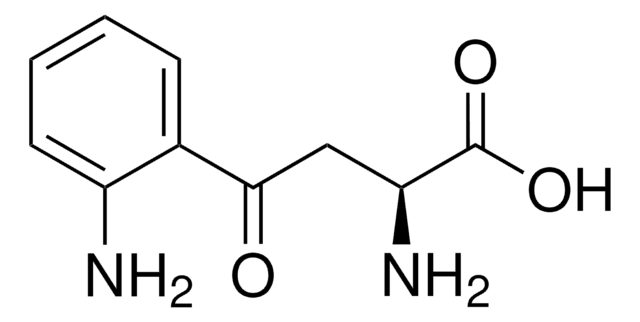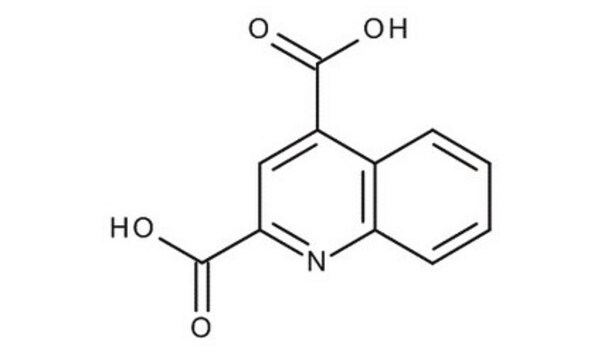P63204
2,3-Pyridinedicarboxylic acid
99%
Sinonimo/i:
Quinolinic acid
Autenticatiper visualizzare i prezzi riservati alla tua organizzazione & contrattuali
About This Item
Formula empirica (notazione di Hill):
C7H5NO4
Numero CAS:
Peso molecolare:
167.12
Beilstein:
137110
Numero CE:
Numero MDL:
Codice UNSPSC:
12352100
ID PubChem:
NACRES:
NA.22
Prodotti consigliati
Livello qualitativo
Saggio
99%
Forma fisica
powder
Punto di fusione
188-190 °C (dec.) (lit.)
Stringa SMILE
OC(=O)c1cccnc1C(O)=O
InChI
1S/C7H5NO4/c9-6(10)4-2-1-3-8-5(4)7(11)12/h1-3H,(H,9,10)(H,11,12)
GJAWHXHKYYXBSV-UHFFFAOYSA-N
Informazioni sul gene
rat ... Gria1(50592) , Grin2a(24409)
Cerchi prodotti simili? Visita Guida al confronto tra prodotti
Categorie correlate
Applicazioni
Inhibits glucose synthesis.
Avvertenze
Warning
Indicazioni di pericolo
Consigli di prudenza
Classi di pericolo
Eye Irrit. 2 - STOT SE 3
Organi bersaglio
Respiratory system
Codice della classe di stoccaggio
11 - Combustible Solids
Classe di pericolosità dell'acqua (WGK)
WGK 3
Dispositivi di protezione individuale
dust mask type N95 (US), Eyeshields, Gloves
Scegli una delle versioni più recenti:
Possiedi già questo prodotto?
I documenti relativi ai prodotti acquistati recentemente sono disponibili nell’Archivio dei documenti.
I clienti hanno visto anche
L Garcia-Salguero et al.
Archives internationales de physiologie, de biochimie et de biophysique, 99(3), 237-242 (1991-06-01)
The in vitro and in vivo effects of several different inhibitors of carbohydrate metabolism have been studied. The in vitro addition of 5-methoxyindole-2-carboxylic acid (MICA), pent-4-enoic acid, and quinolinic acid to the perfusion medium significantly inhibited liver gluconeogenesis in 48-hour-starved
Dorit Cohen-Carmon et al.
Molecular neurobiology, 57(3), 1768-1777 (2019-12-14)
Huntington's disease (HD) is a neurodegenerative late-onset genetic disorder caused by CAG expansions in the coding region of the Huntingtin (HTT) gene, resulting in a poly-glutamine (polyQ) expanded HTT protein. Considerable efforts have been devoted for studying HD and other
Valéry Combes et al.
Trends in parasitology, 28(8), 311-319 (2012-06-26)
Homeostasis implies constant operational defence mechanisms, against both external and internal threats. Infectious agents are prominent among such threats. During infection, the host elicits the release of a vast array of molecules and numerous cell-cell interactions are triggered. These pleiomorphic
Gilles J Guillemin
The FEBS journal, 279(8), 1356-1365 (2012-01-18)
Over the last two decades, evidence for the involvement of quinolinic acid (QUIN) in neuroinflammatory diseases has been exponentially increasing. Within the brain, QUIN is produced and released by infiltrating macrophages and activated microglia, the very cells that are prominent
Gilles J Guillemin et al.
Neuro-degenerative diseases, 2(3-4), 166-176 (2006-08-16)
The kynurenine pathway (KP) is a major route of L-tryptophan catabolism leading to production of several neurobiologically active molecules. Among them is the excitotoxin quinolinic acid (QUIN) that is known to be involved in the pathogenesis of several major inflammatory
Il team dei nostri ricercatori vanta grande esperienza in tutte le aree della ricerca quali Life Science, scienza dei materiali, sintesi chimica, cromatografia, discipline analitiche, ecc..
Contatta l'Assistenza Tecnica.










